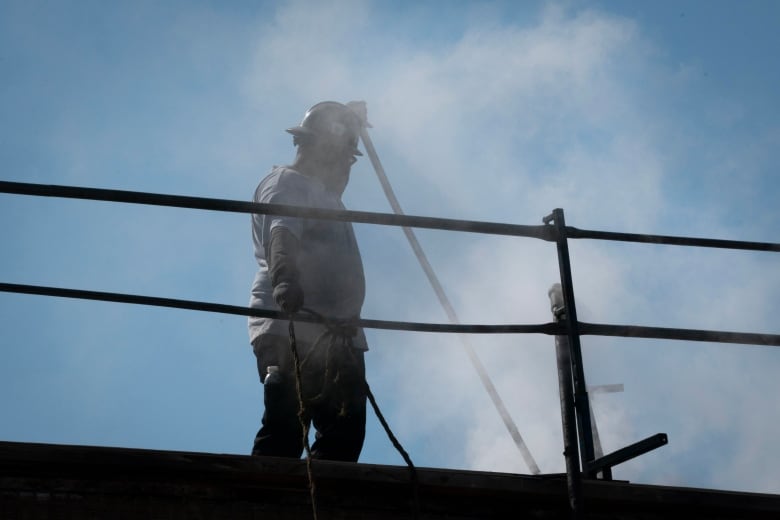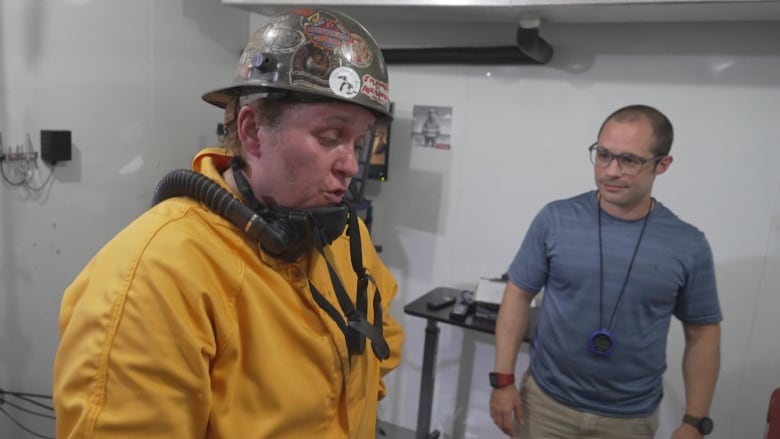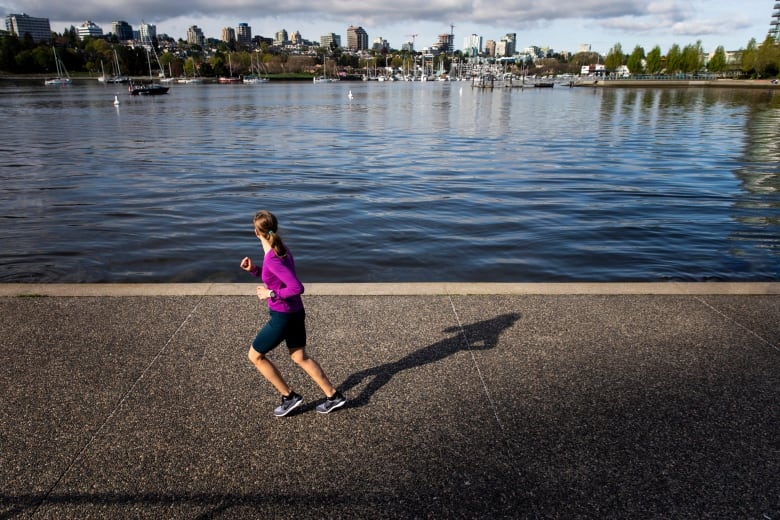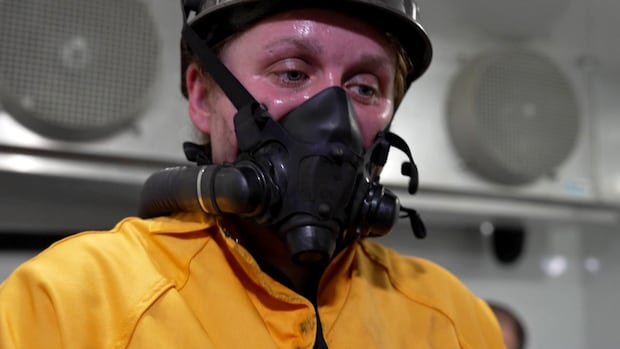
White Coat Black Art26:30Hot as hell
Britnee Miazek didn’t immediately make the connection between her periods stopping and her job as a second-year ironworker apprentice in Sault Ste. Marie, Ont.
It was only after a three-month stint in 2023 working on top of the coke ovens used in the steel-making process that the 35-year-old began to notice a pattern.
“As soon as I switched jobs … my body started producing my menstruation cycle once again,” said Miazek.
She describes the outdoor coke ovens “as hot as humanly possible” and believes the extreme heat they produce might have caused her periods to stop.
Miazek went to see a doctor at a walk-in clinic, who referred her to a gynecologist in Toronto, but she couldn’t go to the appointment due to weather affecting flights.
“I just did the job that I was given and just had to scramble to figure stuff out,” she told Dr. Brian Goldman, host of CBC’s White Coat, Black Art.
As our planet heats up, people like Miazek who work in extremely hot temperatures outside will be further exposed to heat, which increases their risk of heat-related health issues. Yet, endocrinologists and researchers say there’s still a lot to learn about how female bodies deal with extreme heat, especially in life-changing times like perimenopause and pregnancy.

Health impacts of heat waves caused by climate change have already been seen in Canada and other places around the world.
“We’re seeing a real epidemic of long-term clinical problems,” said Stephen Cheung, a kinesiology professor at Ontario’s Brock University.
Specifically, he mentioned problems with the heart, including arrhythmia or coronary heart disease, and kidney issues.
Experts at the U.S. Center for Disease Control (CDC) say excess heat may also affect both men and women’s fertility and overall reproductive health.
Looking for answers
Miazek knows all too well how difficult it is to find answers. She tried researching health effects on women working on coke ovens, but found only information from the 1960s.
“It’s 2024,” she said. “You’d think that we would have some type of research into at least the extreme ends of heat and how it affects women’s bodies.”

That’s why she travelled hundreds of kilometres recently to take part in an experiment at Brock University in St. Catharines, Ont., designed to test how her body responds to extreme heat similar to those she experienced while working on the coke ovens.
During the experiment, Miazek performed several tasks, once at a normal temperature of about 22 C in her regular clothing, then again at a temperature of about 40 C while wearing her work gear.
Cheung, who conducted the experiment, says it will help to better understand the effects of heat on female outdoor workers.
White Coat, Black Art features the story of Britnee Miazek, an ironworker apprentice who undergoes an experiment at Brock University to find out exactly how her body copes with extreme temperatures.
Body temperature
When it comes to heat, a small area in the brain helps to control body temperature, explains Dr. Amita Mahajan, an endocrinologist and professor at the University of Calgary’s Cumming School of Medicine.
Everyone has a hypothalamus that helps maintain core body temperature in a very narrow range, Mahajan says. It also helps to regulate important functions like blood pressure, sleep and in females, reproductive function.
Mahajan says when people like Miazek are exposed to high heat over weeks, the temperatures can increase the body’s basal metabolic rate — the amount of energy needed at rest in a mild environment.
That means the body needs more energy to operate in heat, and unless we take in more calories to meet those demands, Mahajan says there will be an energy mismatch.
“And the hypothalamus — our control centre — is going to sense that,” she told CBC’s The Dose podcast.
The Dose23:28What do we know about how women’s bodies deal with heat?
Experts know that men and women respond to heat differently, but we’re still learning about how women respond to extreme temperatures. Dr. Amita Mahajan, an endocrinologist and clinical assistant professor at the University of Calgary, explains how extreme heat affects women’s bodies and the role that hormones play in regulating their core temperatures.
For transcripts of The Dose, please visit: lnk.to/dose-transcripts. Transcripts of each episode will be made available by the next workday. For more episodes of this podcast, click this link. [https://podcasts.apple.com/us/podcast/the-dose/id1498259551]
Research shows that during times of stress, the hypothalamus will sometimes tell the body to stop ovulation and menstruation, instead focusing on core functions.
Mahajan notes there isn’t a ton of data on how the hypothalamus functions in females compared to males during hot temperatures, except for some small-scale research into high-intensity exercise.
Females fare better in hot, humid environments “because their body doesn’t tell them to sweat as quickly as male bodies would,” she said, adding that on the flip side, males do better in hot, dry environments because they can sweat and lower their body temperature faster.

Role of estrogen, progesterone
Mahajan says researchers and medical experts know more about body temperature changes throughout the menstrual cycle, which could affect how females feel heat.
She says high levels of estrogen — the dominant hormone in the first half of a female’s cycle — causes the body temperature to be on the lower end.
In the second half of the cycle, lower levels of estrogen and higher progesterone levels can cause the body temperature to rise anywhere from 0.4 to 0.8 degrees. The increase in progesterone during this phase of the cycle may mean a female “may feel subjectively a bit warmer,” according to Mahajan.
“It’s really important to listen to your body and understand that you may not be feeling the same way you do in the second half of your cycle,” she said.
Pregnancy
Research has shown that pregnant people are more susceptible to intense changes in heat due to higher body surface area, increased blood flow and basal metabolic rate.
“They do need to be cognizant that heat can affect them quicker and worse than it would have pre-pregnancy,” Mahajan said.
She notes that those who are expecting may also notice a higher core body temperature in the first trimester, when progesterone levels are higher.
In the second and third trimesters, when estrogen levels are high, the core body temperature will be lower and more efficient at getting rid of heat, likely to protect the fetus, says Mahajan.
Pregnant people are also more likely to become dehydrated, so she recommends 2.5 to three litres of water a day.
Perimenopause and beyond
Temperature changes can happen across a female’s life, including perimenopause and menopause. Hot flashes, experienced by many during this time, happen because of fluctuations in estrogen.
The threshold for sweating also changes during this time. For those not going through perimenopause, sweating starts if the body temperature goes up by 0.4 to 0.5 degrees.
For females in perimenopause or menopause, the body temperature only needs to go up by 0.1 to 0.2 degrees before sweating begins, Mahajan says.
She recommends women in perimenopause or menopause do the following to stay cool:
- Avoid prolonged heat exposure
- Drink plenty of water
- Avoid spicy foods, caffeine and alcohol
Dr. Jerilynn Prior, an endocrinologist and professor at University of British Columbia, advises people to watch for signs of heat stress, and to drink salty liquids when working in hot environments.

“Pay attention to your body. Is your heart beating too fast? That’s an important sign that you need to get to somewhere cooler,” she said. “You need to drink more and do less activity.”
Still looking for answers
For Miazek, the experiment she took part in showed that while working at higher temperatures, her heart beat faster, and both her sweating and skin temperature increased.
Although she doesn’t have a definitive answer as to why she missed her period for several months, she’s glad to contribute to research about how women respond to heat.
“It’s not about who has it worse. It’s literally just about the differences and how it affects male and female bodies differently.”

This story is part of our Overheated series, a collaboration between What on Earth, Quirks & Quarks, and White Coat, Black Art, that explores how heat is affecting our health, our cities and our ecosystems.
